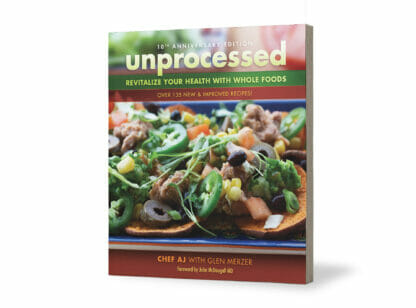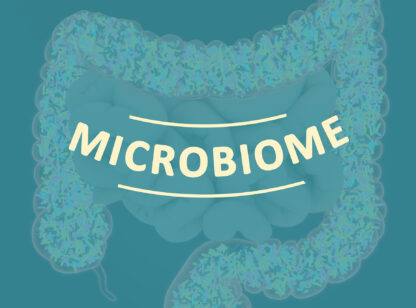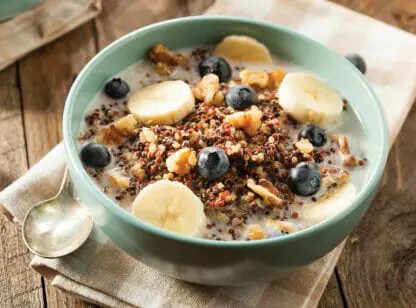It is wonderful to see our government actively promoting the importance of eating more fresh fruits and vegetables. In March 2007, the Centers for Disease Control & Prevention (CDC) launched the “Fruits & Veggies—More Matters” campaign promoting the benefits of fruits and vegetables in a way that will sustain consumers’ eating behavior in the long term.
As we now live with the successful – yet debilitating – results of Washington’s 70 year-old national push to eat more grain, we can only hope that the Fruits & Veggies message gains even greater momentum and mass appeal.
In 2010, a study on America’s consumption of fruits and vegetables entitled “State of the Plate” was conducted by the Produce for Better Health Foundation (PBH) in association with the CDC. Their findings concluded that:
- Only 6% of Americans eat their recommended veggies each day
- Americans eat 2/3 of their veggies at dinner
- Children ages 2-12, males 18-34, and females 18-54 have increased fruit and vegetable consumption by at least 5% since 2004
- Teens and those 65 and older appear to be eating less fruits and veggies
- The average American consumes less than 2 cups of fruits and veggies each day while it should be 4-5 cups!
Most of us weren’t raised to consider vegetables a primary part of each meal. They were always the sidekick, and in today’s society of “fast and easy,” veggies don’t always make the cut. But the mindset can change, and it begins with changing daily habits.
Here are a few easy tips to get you started:
Drink your vegetables
For a nutritious snack or light meal, throw your veggies into a blender. Adding a handful of spinach or kale to frozen fruit, almond milk, protein powder, and a banana or spoonful of Greek yogurt (to thicken) is a wonderful, sweet snack. Add a bit of granola so you chew your smoothie (see page 15). And the secret ingredient to cut the veggie taste? A few dashes of cinnamon! For a grab and go, try Evolution Fresh beverages ‘Sweet Greens and Lemon’ now readily available at places like Starbucks.
Build your meal around the vegetable
We have grown up building our meals around the protein (chicken, fish, meat). Change your mindset and think first of your vegetable. Center the vegetable on your plate and give it the largest portion. Use whatever you have readily available! If you have zucchinis, onions, mushrooms and broccoli, cut them up for a delicious stir fry served over rice or quinoa – and then add some diced chicken or beef. Have a couple of beefsteak tomatoes in the fridge? Hollow them out and stuff them with tuna or chicken salad.
Replace something in your diet with vegetables
Do you like to snack? How about replacing packaged snacks with vegetables? Cut up raw zucchini, summer squash and cucumbers, and buy baby carrots and cherry tomatoes. Place them in small plastic bags for a quick and easy snack to grab and take with you. You now have a crunchy, finger food ( just like chips) that is much better for you. Variety is key and you’ll be surprised at how satisfying they are.
Side orders. When dining out, make vegetables your side order of choice. You’ll feel better in the morning if you replace buttery mashed potatoes or french fries with a grilled veggie mix or steamed broccoli.
Give up meat. Vegetables then become your primary food and you’ll enjoy a whole world of vegetarian delights. Most restaurants now offer vegetarian options above and beyond salads. You can obtain your protein through many other foods including fish, soy, eggs, beans, cheese and protein powders.
Eat veggies at every meal
Throw chopped veggies into your eggs (mince or grate if you’d rather not taste large chunks). Swap fruit juice for veggie juice in the morning. Add avocado to your sandwich – or replace that sandwich with a vegetable salad. For lunch, choose the salad bar over fast, fried food.
Give up Iceberg
Are you still eating iceberg lettuce? Go greener. Calorie for calorie, dark leafy greens are probably the most concentrated source of nutrition of any food. They are also shown to prevent many forms of disease including cancer.1 Make your salads with these tasty super greens: baby kale (less bitter than regular kale), swiss chard, spinach, radicchio, shredded cabbage, and tatsoi. Organic Girl, available at Ralphs, provides prepackaged mixes for ready-to-go salads and to toss into smoothies.
Go vegetarian at least twice a week
Make a conscious effort to eat only vegetables a couple of times a week. This will encourage you to explore recipes and experiment with new vegetables to keep menus interesting and exciting.
Grill your veggies
What are we going to grill tonight? How about bell peppers, halved tomatoes, onions and zucchini, and oh yeah, some tri tip on the side? Marinate big chucks of vegetables for easy flipping, or build tasty kabobs.
Don’t like veggies?
Spice it up! Don’t be afraid to dip, soak or sauce. Olive oil mixed with your favorite spices, curries, peanut sauce, or sesame are great additions to cooked vegetables. Hummus, low fat ranch dressing, and yogurt dips make raw veggies go down a lot easier.
Add veggies you almost like to dishes you already love. Layer zucchini slices, chopped spinach, or cooked carrots into lasagna. Stir broccoli florets into macaroni and cheese. Toss tomatoes, spinach, mushrooms, broccoli, or asparagus into an omelet or quesadilla. Add veggies to your pizza, pasta, or sauces.2
Know how to cook the stronger flavored veggies. The strongest tasting vegetables are those in the cruciferous family (cabbage, broccoli, cauliflower, and brussel sprouts), along with some greens, and raw eggplant. Keep in mind that generally, the longer you cook these veggies, the stronger their odor and flavor (however, eggplant actually becomes milder with cooking). To cut the bitterness of these veggies, add a little olive oil when stir-frying or sautéing; add something salty or sour like a drizzle of light soy sauce, balsamic vinegar, lemon, or shredded Parmesan; or glaze the vegetables with something sweet like a small spoonful of honey or orange marmalade.2
Eat quality vegetables…or grow your own!
If you’ve ever had a tomato right off the vine, you realize the difference quality can make. Three of the freshest options are to visit one of the Valley’s Certified Farmers Markets or to buy a Community Supported Agriculture (CSA) box consisting of new, freshly picked, organic produce from local farmers. Inland Empire CSA makes weekly deliveries to pickup locations throughout the Valley and boxes range from $24-$36 per week. Nutritional consultant, Libby Quigley, RD, recommends that you grow your own. “There is a great satisfaction in establishing, nurturing and enjoying the bounty from your very own garden.”
Adopting just one of these healthy habits can significantly increase your daily veggie intake. It’s important to think of incorporating these changes as a lifestyle choice, and not a diet. Realize that you are not eating more veggies to lose weight, but to live a longer, healthier and happier life!
References: 1) American Institute for Cancer Research. http://preventcancer.aicr.org. Foods That Fight Cancer; 2) By Elaine Magee, MPH, RD WebMD.com Eat Your Vegetables: 15 Tips for Veggie Haters

















































Comments (0)